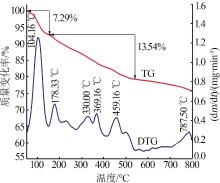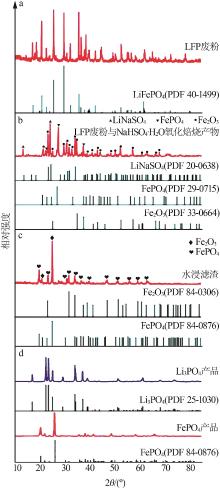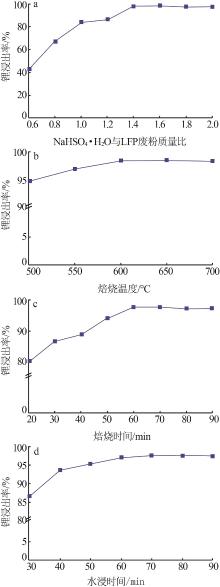| 1 |
郭举,贾双珠.水热法一步合成磷酸铁锂及其性能研究[J].无机盐工业,2020,52(6):36-40.
|
|
GUO Ju, JIA Shuangzhu.Study on the one-step hydrothermal synthesis of LiFePO4 and its properties[J].Inorganic Chemicals Industry,2020,52(6):36-40.
|
| 2 |
张克杰,陈鹏,谢旺旺,等.磷酸铁锂优缺点及改性研究进展[J].无机盐工业,2018,50(6):13-17.
|
|
ZHANG Kejie, CHEN Peng, XIE Wangwang,et al.Progress in modification of lithium iron phosphate and its advantages and disadvantages[J].Inorganic Chemicals Industry,2018,50(6):13-17.
|
| 3 |
吴小龙,王晨麟,陈曦,等.废旧锂离子电池市场规模及回收利用技术[J].环境科学与技术,2020,43(S2):179-183.
|
|
WU Xiaolong, WANG Chenlin, CHEN Xi,et al.Market scale and recycling technology of waste lithium-ion batteries[J].Environmental Science & Technology,2020,43(S2):179-183.
|
| 4 |
TAO Shengdong, LI Jian, WANG Lihua,et al.A method for recovering Li3PO4 from spent lithium iron phosphate cathode material through high-temperature activation[J].Ionics,2019,25(12):5643-5653.
|
| 5 |
BI Haijun, ZHU Huabing, ZU Lei,et al.Environment-friendly technology for recovering cathode materials from spent lithium iron phosphate batteries[J].Waste Management & Research:the Journal of the International Solid Wastes and Public Cleansing Association,ISWA,2020,38(8):911-920.
|
| 6 |
王甲泰,赵段,马莲花,等.锂离子电池正极材料磷酸铁锂的研究进展[J].无机盐工业,2020,52(4):18-22.
|
|
WANG Jiatai, ZHAO Duan, MA Lianhua,et al.Research progress of LiFePO4 cathode materials for Li-ion battery[J].Inorganic Chemicals Industry,2020,52(4):18-22.
|
| 7 |
YANG Yongxia, ZHENG Xiaohong, CAO Hongbin,et al.A closed-loop process for selective metal recovery from spent lithium iron phosphate batteries through mechanochemical activation[J].ACS Sustainable Chemistry & Engineering,2017,5(11):9972-9980.
|
| 8 |
WANG Mengmeng, LIU Kang, DUTTA S,et al.Recycling of lithium iron phosphate batteries:Status,technologies,challenges,and prospects[J].Renewable and Sustainable Energy Reviews,2022,163.Doi:10.1016/j.rser.2022.112515.
|
| 9 |
WANG Dahui, ZHANG Xiaodong, CHEN Huaijing,et al.Separation of Li and Co from the active mass of spent Li-ion batteries by selective sulfating roasting with sodium bisulfate and water leaching[J].Minerals Engineering,2018,126:28-35.
|
| 10 |
SUN Sen, YU Xiaoping, LI Mingli,et al.Green recovery of lithium from geothermal water based on a novel lithium iron phosphate electrochemical technique[J].Journal of Cleaner Production,2020,247.Doi:10.1016/j.jclepro.2019.119178.
|
| 11 |
LI Huan, XING Shengzhou, LIU Yu,et al.Recovery of lithium,iron,and phosphorus from spent LiFePO4 batteries using stoichiometric sulfuric acid leaching system[J].ACS Sustainable Chemistry & Engineering,2017,5(9):8017-8024.
|
| 12 |
高洁,夏永高.一种从废旧磷酸铁锂电池中回收锂的方法以及回收锂和磷酸铁的方法:中国,111675203A[P].2021-12-14.
|
| 13 |
ZHANG Beilei, QU Xin, CHEN Xiang,et al.A sodium salt-assisted roasting approach followed by leaching for recovering spent LiFePO4 batteries[J].Journal of Hazardous Materials,2022,424.Doi:10.1016/j.jhazmat.2021.127586.
|
| 14 |
LI Haoyu, YE Hua, SUN Mingcang,et al.Process for recycle of spent lithium iron phosphate battery via a selective leaching-precipitation method[J].Journal of Central South University,2020,27(11):3239-3248.
|
| 15 |
MAHANDRA H, GHAHREMAN A.A sustainable process for selective recovery of lithium as lithium phosphate from spent LiFePO4 batteries[J].Resources,Conservation and Recycling,2021,175.Doi:10.1016/j.resconrec.2021.105883.
|
| 16 |
魏永刚,曲国瑞,王华,等.一种从废旧锂离子电池中火法回收锂的方法:中国,113061725A[P].2021-07-02.
|
| 17 |
FORTE F, PIETRANTONIO M, PUCCIARMATI S,et al.Lithium iron phosphate batteries recycling:An assessment of current status[J].Critical Reviews in Environmental Science and Technology,2021,51(19):2232-2259.
|
| 18 |
SHENTU Huajian, XIANG Bo, CHENG Yajun,et al.A fast and efficient method for selective extraction of lithium from spent lithium iron phosphate battery[J].Environmental Technology & Innovation,2021,23.Doi:10.1016/j.eti.2021.101569.
|
| 19 |
王炼,王建波,陈梦君,等.废锂电池破碎及碱浸除铝特性[J].环境科学与技术,2017,40(S2):102-106.
|
|
WANG Lian, WANG Jianbo, CHEN Mengjun,et al.Shear breaking and Al removing by alkaline leachate for spent lithium batteries[J].Environmental Science & Technology,2017,40(S2):102-106.
|
| 20 |
蒋伟.二水磷酸铁脱水工艺研究[J].安徽化工,2019,45(3):59-61.
|
|
JIANG Wei.Dehydration of ferric phosphate dihydrate[J].Anhui Chemical Industry,2019,45(3):59-61.
|
 ), ZHANG Liangjun, KUANG Huan, JIANG Manwen(
), ZHANG Liangjun, KUANG Huan, JIANG Manwen( ), XIAO Li
), XIAO Li









